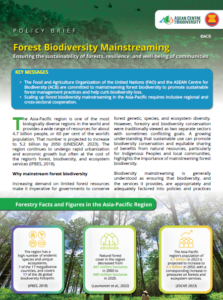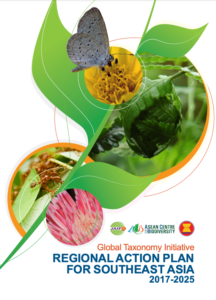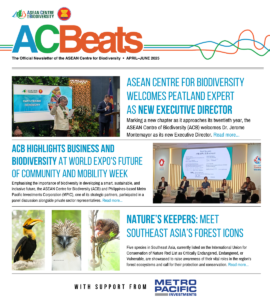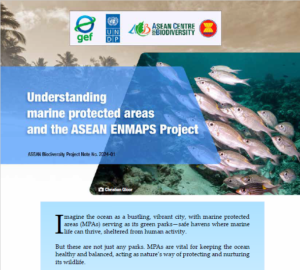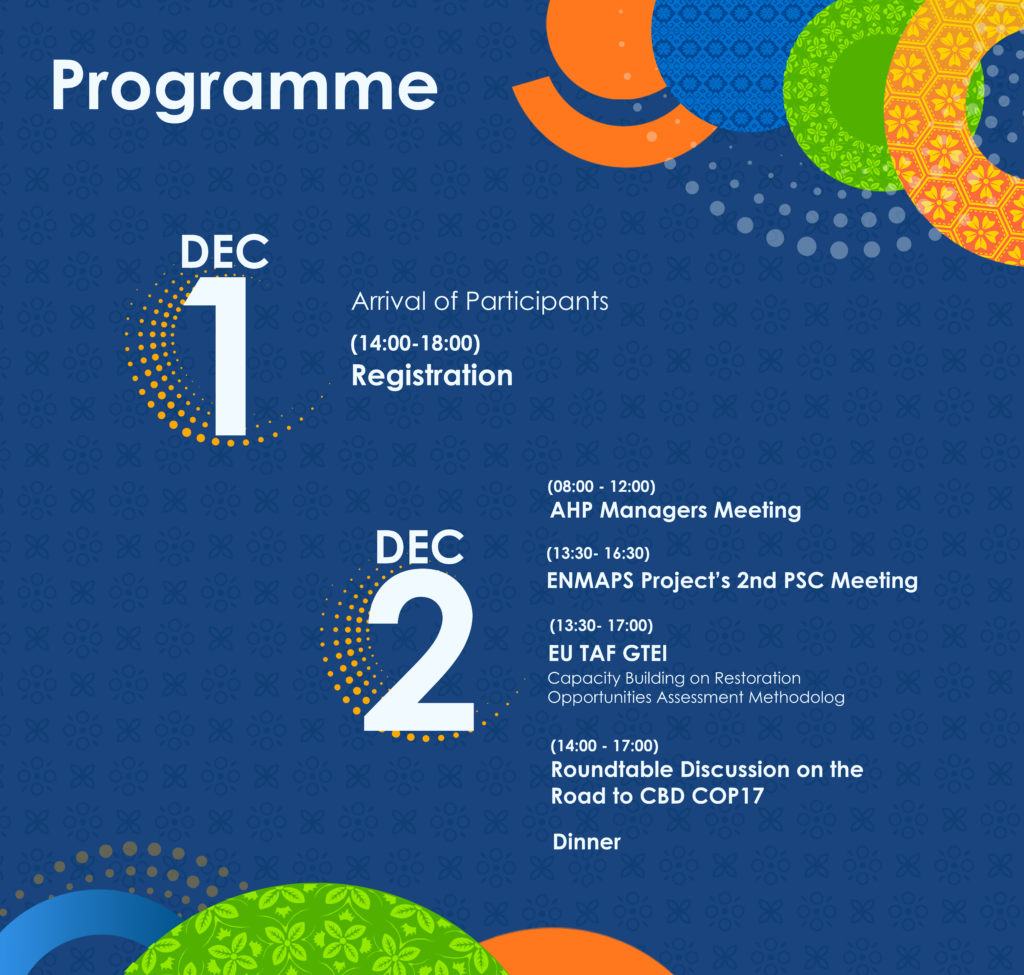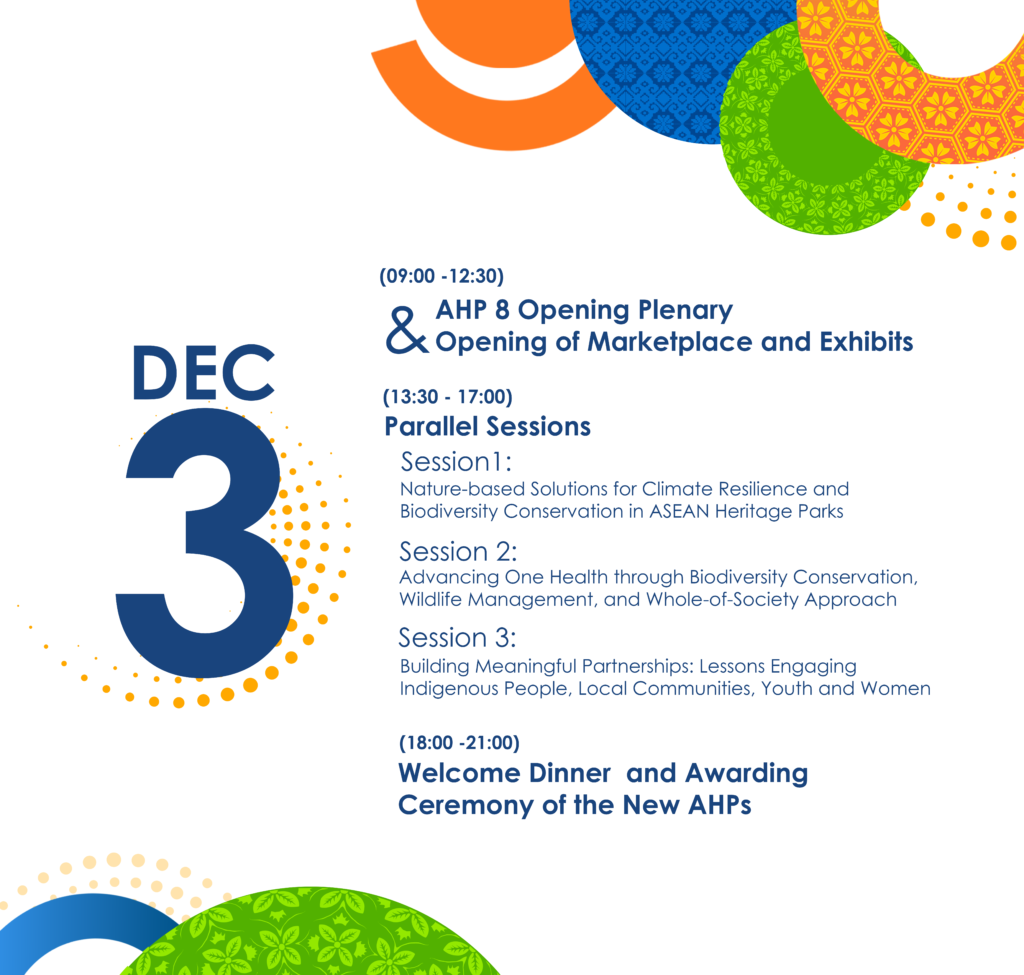Ms. Clarissa C. Arida
Acting Executive Director, ASEAN Centre for Biodiversity
Zosterops sp. in a colourful, feathered frolic. Photo: Jose Roberto Gonzaga Villabona
Southeast Asia is one of the most vulnerable regions to climate change and its impacts. This is evident in the increasing number, unpredictability, and intensity of extreme weather events such as rising sea levels, heat waves, floods, and droughts. From 1993 to 2022, the 2025 Global Climate Risk Index has listed Myanmar and the Philippines among the top 10 countries affected by climate change. Climate change has exposed us to both social and economic consequences. In the same period, typhoons, floods, and droughts in these two countries have resulted in nearly 150,000 deaths and around USD 40 billion in losses.
Our ecosystems, such as forests, rangelands, croplands, peatlands, and wetlands, act as carbon sinks, providing so-called nature-based solutions (NbS) to climate change. However, these natural defences are also threatened by climate change and further exacerbated by unsustainable human activities. This diminishes the capacity of our environment to assimilate and store carbon dioxide, prompting the need for urgent action.
In 2021, the UN Decade on Ecosystem Restoration was initiated as a global call for the protection and revival of ecosystems worldwide for the benefit of people and nature. Being halfway through this decade prompts us to check how much we have accomplished in responding to the urgent need to halt and reverse ecosystem degradation.
As we celebrate this year’s International Mother Earth Day with the theme “Our Power, Our Planet,” the ASEAN Centre for Biodiversity (ACB) explores the critical link between ecosystem restoration and adapting NbS as both a mitigation and adaptation measure that can provide multiple and long-term benefits. This includes the transition to renewable energy sources.
Mainstreaming biodiversity in renewable energy
Renewable energy sources produce significantly less greenhouse gas emissions than fossil fuels, mitigating climate change and its impacts on ecosystems. According to the Organisation for Economic Cooperation and Development, increasing the use of renewable power is crucial to limiting the global average temperature rise to 1.5°C.
However, shifting to renewable energy solutions needs careful planning and implementation to ensure it does not compromise other efforts to increase the ecosystem’s capacity to sequester carbon or undermine other commitments to stop and reverse biodiversity loss under the Kunming-Montreal Global Biodiversity Framework.
This demands an integrated approach beyond political borders to minimise trade-offs and avoid unintended consequences. There is a need for infrastructure developed to harvest renewable energy to take into consideration impacts on biodiversity such as the direct mortality of species through collision or electrocution; the loss, degradation and fragmentation of habitat; barriers to species movement; habitat alteration; changes in behaviour and physiology; and impacts on ecosystem services. One way to ensure these would not happen is by conducting thorough environmental impact assessments and adopting biodiversity-friendly practices, such as locating wind and solar farms to avoid critical habitats and species migration routes.
Other ecosystem restoration efforts
The UN Convention on Biological Diversity has identified several biodiversity conservation approaches that can help mitigate and adapt to the adverse impacts of climate change. These include reducing deforestation and other land-use changes, restoring degraded lands and ecosystems, and enhancing soil management in agricultural and range lands.
This is reflected in one of the ACB’s flagship initiatives— the ASEAN Heritage Parks (AHP) Programme. This initiative recognises and supports protected areas of high conservation importance with unique biodiversity ecosystems in the region. These protected areas are regarded as safeguards of biodiversity and help reduce the risks of climate change impacts. However, these benefits can only be guaranteed when these areas are effectively managed. Because of this, the ACB continues to work with the ASEAN Member States (AMS) and with different development partners to continuously build and improve the capacity of protected area managers and stakeholders.
Another regional initiative, the Effectively Managing Networks of Marine Protected Areas in Large Marine Ecosystems in the ASEAN Region (ASEAN ENMAPS), is designed to enhance the management of networks of marine protected areas and marine corridors within selected large marine ecosystems in Indonesia, the Philippines, and Thailand. Implemented by the UNDP in Asia and the Pacific through funding support from the Global Environment Facility and with the ACB as the executing agency, it can greatly support current climate change mitigation efforts, increase resilience to unfavourable environmental changes, and support sustainable fisheries and other ecosystem goods and services.
Since 2023, the ACB has partnered with the Manila Observatory for the ASEAN Climate and Biodiversity Initiative. This platform facilitates active engagement and the sharing of scientific information among scientists, climate and biodiversity experts, researchers, and communicators. It aims to clarify the connection between biodiversity and climate change and emphasise the role of biodiversity as a nature-based solution to the climate crisis. The initiative is being piloted in selected areas in the Philippines and will then be scaled up to cover other critical areas in the ASEAN Member States. Building on its strong collaboration with the Coordinated Regional Climate Downscaling Experiment – Southeast Asia (CORDEX-SEA), the Manila Observatory will focus on generating necessary climate information for impact studies on biodiversity.
The ASEAN Green Initiative (AGI) is another related flagship activity that mirrors the region’s commitment to conserving its rich biodiversity, which is the source of ecosystem services vital to our survival. Through the AGI, the ASEAN encourages planting at least 10 million native trees across the 10 AMS in 10 years, which aligns with the UN Decade on Ecosystem Restoration. Since ecosystem restoration requires a whole-of-society approach, the success of the AGI relies on the commitment of all AMS governments, citizens, partners, and advocates to contribute, collaborate, and cooperate.
In partnership with the Global Environment Centre, the ACB is also implementing the Enhancing Conservation and Restoration of Wetlands and Peatlands in ASEAN as Effective Sinks and Reservoirs of Greenhouse Gases (EnCORE Wetlands). This project aims to accelerate emissions reductions through the conservation, protection and restoration of wetland and peatland ecosystems in the ASEAN region, reducing the impact of climate change on the most vulnerable. The project is expected to establish evidence-informed policies, practices, tools, and technologies to support inclusive biodiversity conservation in carbon-rich ecosystems in pilot sites—Maludam National Park in Malaysia and Agusan Marsh Wildlife Sanctuary in the Philippines, with the potential for broader replication across the AMS.
The Philippines’ 5 Million Trees: Forests for Life Program
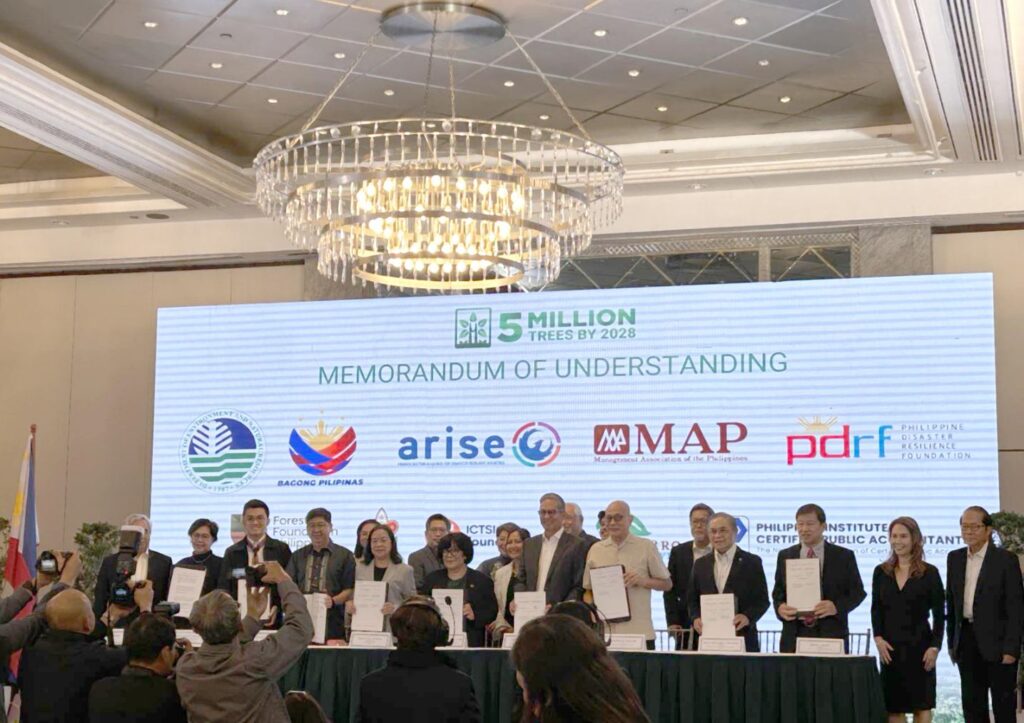
The Philippine Department of Environment and Natural Resources through Secretary Maria Antonia Yulo Loyzaga, inked a memorandum of understanding with eight private sector companies during the launch of the ‘Forest for Life’ program. These are Aboitiz Equity Ventures, DMCI Mining Corporation, First Philippine Holdings, Metro Pacific Investments, Petron, San Miguel Global Power, Prime Infrastructure Capital, and SM Prime Holdings.
As part of the International Day of Forests last month, the Philippines launched an ecosystem restoration initiative as part of the Expanded National Greening Program, which aims to help rehabilitate 15,508 hectares of degraded land and maintain over 44,000 hectares of reforested areas.
Led by the country’s Department of Environment and Natural Resources (DENR), “Forests for Life: 5 Million Trees by 2028” is a four-year reforestation programme that aims to plant at least five million trees in the next three years across key provinces to restore vital forest ecosystems, improve biodiversity and water resources, and reduce soil erosion. The programme is expected to contribute about 3.5 million tons of carbon by 2038, and be able to measure the amount of carbon sequestration annually and over the following decade.
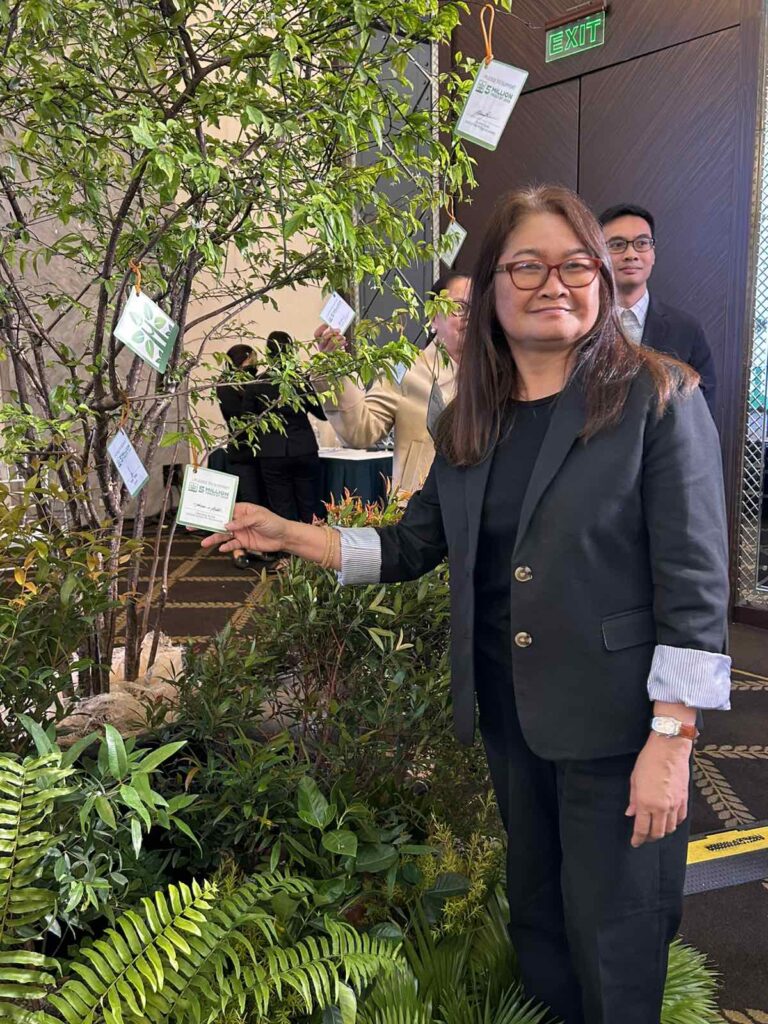
Representing the ACB, Acting Executive Director Clarissa C. Arida joins the Philippines’ whole-of-society approach and multistakeholder collaboration programme for ecological rehabilitation and climate resilience.

L-R: ACB Acting Executive Director Clarissa C. Arida joins officials from the Philippine Department of Environment and Natural Resources, including Atty. Juan Miguel T. Cuna, DENR Undersecretary for Luzon Field Operations and Supervising Undersecretary for EMB for Luzon and Visayas; Atty. Jonas R. Leones, Undersecretary for Policy, Planning, and International Affairs; Atty. Ernesto D. Adobo, Jr., Undersecretary for Legal and Administration, and Dr. Henry A. Adornado, Regional Executive Director of the DENR Region 10, at the launch of the “Forests for Life: 5 Million Trees by 2028” project in Makati City last month.
In her speech, DENR Secretary Maria Antonia Yulo Loyzaga underscored the critical role of ‘targeted and aggressive reforestation to minimise the impacts of climate change, particularly in flood-prone and watershed areas. She cited the initiative’s multiple benefits, which include enhanced biodiversity, improved water resources, mitigated soil erosion, and strengthened community livelihoods.
Six priority areas have been identified for the project: Bataan, Bukidnon, Lanao del Norte, Ilocos Norte, Rizal, and Leyte.
A call to harness our collective power
Our region’s rich biodiversity is a crucial asset in achieving climate change resilience. The ACB continues to call on governments, civil society, the private sector, and other stakeholders for greater, more impactful collaboration on various ecosystem restoration initiatives. The ACB also emphasises the importance of integrating social and environmental considerations into the shift towards renewable energy to ensure a sustainable and resilient future where we live in harmony with nature.
The success of our collective action is our true power—let us use it for our planet, for us, and for generations to come.


